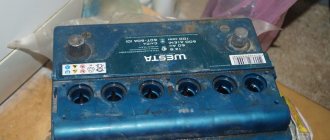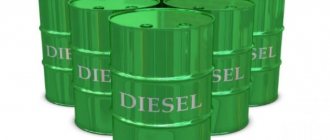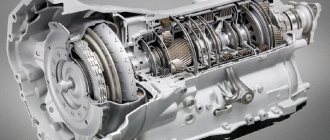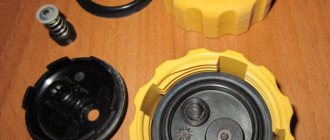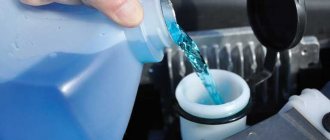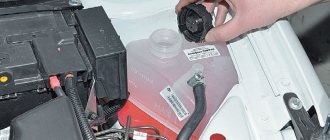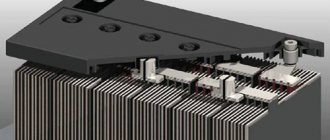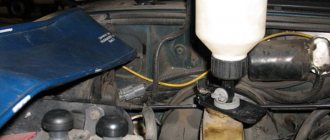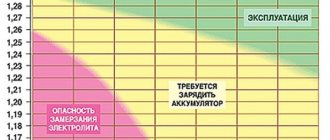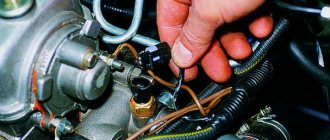How to check antifreeze and antifreeze. Simple ways to check coolant quality
Having chosen and purchased an antifreeze fluid for the cooling system, every car enthusiast wants it to actually have the properties stated on the label.
According to recent studies, the share of counterfeit products in the antifreeze liquid market ranges from 40 to 50%. Despite the nice plastic container and neatly made stickers on it, there may be a liquid inside that only vaguely resembles domestic antifreeze or foreign antifreeze. Where is the guarantee that the inside of the canister is not colored water, flavored with battery electrolyte, or water with added sugar or salt?
Why is counterfeit dangerous?
What happens to antifreeze (or antifreeze) poured into the cooling system when its temperature drops to the value (for example, -40 0 C) indicated on the packaging? It crystallizes and the antifreeze loses its fluidity, turning into a kind of jelly. At the same time, it does not increase in volume, therefore it does not put pressure on the internal walls of the radiator and the “jackets” of the cooling system.
The picture is completely different if instead of a non-freezing liquid in the cooling system there is a counterfeit made from ordinary water. Having reached zero temperature, the water freezes, noticeably increasing in volume, and since the cooling system is conditionally sealed, the resulting ice simply crushes and breaks the radiator channels, water pump and engine cylinder block.
Even if the counterfeit antifreeze still contains some part of ethylene glycol and it does not freeze but crystallizes as the temperature drops, it is unlikely that the counterfeiters bothered to add special anti-corrosion additives to its composition that envelop the non-freezing liquid with a protective film.
Consequently, an aggressive liquid, which is a mixture of water and alcohol, will immediately begin to corrode parts of the engine cooling system. It is unlikely that the engine will withstand at least one season of operation in such conditions.
It is almost impossible to check the presence of protective additives at home, but anyone can find out whether an antifreeze liquid can cope with the cold.
Litmus paper
By moistening the litmus paper with the coolant, the quality of which needs to be determined, and then comparing the color it acquires with a special color scale, it will not be difficult to determine its pH with sufficient accuracy.
If there is no such scale, it doesn’t matter; the approximate acid-base balance of antifreeze can be determined “by eye.” Coloring litmus pink will indicate that there is an excess of acid in the liquid being tested (pH ranges from 1 to 5), and this is direct evidence of counterfeiting.
The blue color of litmus paper will indicate a pronounced alkaline environment with pH > 10, therefore such antifreeze or antifreeze is also a fake, and of disgusting quality.
If the litmus turns green, you know that this is a decent quality antifreeze with an acid-base balance of pH ranging from 7 to 9.
Hydrometer
In addition to measuring the density of the electrolyte, modern aerometers can determine the freezing point of antifreeze. Such hydrometers have a scale graduated in degrees next to the density scale.
Having collected antifreeze or antifreeze into the hydrometer using a rubber bulb, it is necessary to determine the line of contact of the tested liquid with the hydrometer rod. Finding a line in the area of the green scale will indicate the crystallization temperature of antifreeze in the range from -30 to -40 0 C. If the indicator points to the red scale, then the coolant has partially lost its properties and will begin to crystallize at a temperature from -20 to -30 0 C. The yellow scale corresponds to the temperature range from -10 to -20 0 C. If the tested liquid in the hydrometer comes into contact with the hydrometer rod in the area of the blue scale, such antifreeze should be replaced immediately, since it has become completely unusable and will behave like ordinary water.
Test freezing
Having collected 100-150 ml of the test liquid into a small plastic bottle, you need to squeeze the bottle a little before tightening the cap, releasing the air from it - suddenly the antifreeze turns out to be fake and after freezing it will crush the plastic container.
After placing the bottle of liquid in the freezer and waiting 1-2 hours, you need to remove the prototype and study it. The temperature in the freezer reaches about -35 0 C, so if the liquid under study has not frozen and has not undergone crystallization at this temperature, it is guaranteed to withstand even more severe frosts, ensuring reliable and stable operation of the engine in winter.
Did you like the article? Subscribe to the channel to stay up to date with the most interesting materials
At what temperature does coolant freeze?
The freezing point of antifreeze or antifreeze is an important parameter that you should pay attention to when choosing consumables. If you live in the northern region, then you need to select a coolant that can not freeze at low temperatures. Next, we will talk in detail about the freezing temperatures of antifreeze and antifreeze.
Antifreeze
It is impossible to say exactly what the freezing point of antifreeze is. This is because antifreeze from each individual manufacturer has its own characteristics, as well as a package of additives that directly affects its performance properties. The manufacturer may change the composition, as a result of which the properties will change.
In addition, the freezing point is greatly influenced by the class of liquid to which it corresponds. For example, consumables of a higher class and, accordingly, more expensive in cost, are more resistant to cold than low-quality substances. It’s worth noting right away: if you purchase products from an unverified manufacturer or a low-quality liquid, then you should not expect anything supernatural from the operation of such consumables.
Antifreeze made in Russia
Today, the entire automobile market of Russia, Ukraine and Belarus, as well as other countries of the former CIS, is literally teeming with counterfeits. When choosing a refrigerant, pay attention not only to its performance properties, but also to the compatibility of the composition and additional additive package with your engine.
As you know, antifreezes are divided among themselves not only by performance properties, but also by international standards G11, G12 and G13. There are no fundamental differences in their composition; the difference lies only in access to certain vehicle models. On average, the freezing point of original consumables that meet the G11 standard is 40 degrees below zero. For standards G12 and G13 - 80 degrees.
Of course, if you dilute it with water in proportions of 1:2, where one liter of antifreeze and two liters of water, then reduce the freezing point by half. The average cost of such a coolant on the domestic market is from 130 hryvnia (400 rubles) per liter of consumables. The price for antifreeze is considerable, however, it is recommended to change fluids of the G11 standard at least once every two years, and the service life of coolants of the G12 and G13 standards is five years.
Read more: Ashton Kutcher's $2 million motorhome. « The very best in the world of cars
Motul coolant meeting G13 standard
But this is all about high quality coolant. If you buy Russian or Ukrainian-made liquid, you must understand that it will not have the same high properties as General Motors antifreeze (standards G 11, G12 and G13). In the domestic car market you can find coolant that freezes at 25 degrees below zero.
In general, it all depends on the manufacturer. When buying consumables, pay attention to the label: usually it contains all the information that the driver needs to know before using the substance.
"Antifreeze"
As for the domestic “Antifreeze”, everything here is identical to antifreeze. Antifreeze itself is a domestically produced consumable, so it is more often used in Russian and Ukrainian cars than in foreign cars.
Russian-made antifreeze A40
Today, dozens of companies across the country are engaged in the production of Antifreeze. And although the composition of the consumable material may vary depending on the manufacturer, the temperature properties are almost the same. In particular, if the antifreeze package says OZH-40, then the freezing point is 40 degrees below zero.
As a rule, most consumables produced in Russia and Ukraine have exactly this freezing threshold. There are liquids that begin the crystallization process at lower temperatures (-50 degrees, -65 degrees). Again, it all depends on the manufacturer, so when choosing “Antifreeze”, pay attention to the packaging label.
Antifreeze with water
Recently, motorists have increasingly practiced mixing coolants with water. The cultivation of concentrate came to us from Europe. Please note that Antifreeze itself consists of 60 or even 70 percent water, and only the remaining 30-40% is ethylene glycol and additional additives.
Antifreeze from General Motors, meeting the international standard G12
When you operate your car in the summer at high temperatures, water evaporates from the coolant, and accordingly, its level drops. Of course, if you have no leaks in the cooling system, then there can be no talk of any evaporation. Therefore, if you notice a decrease in the coolant level in the expansion tank, but are sure that there are no leaks in the system of your car, then adding water will not cause any harm.
But if you drive in winter and the antifreeze level regularly drops, then under no circumstances add water. If you overdo it with water, you may encounter problems with coolant freezing. Also remember: never fill the expansion tank with tap water. It is full of harmful substances that have a destructive effect on the internal components of the cooling system.
Below are the proportions of coolant freezing when mixed with water:
- “Antifreeze”, diluted with distilled water in proportions of one to one, will begin the process of crystallization (freezing) at 35-40 degrees below zero.
- If you mix “Antifreeze” with distillate in a ratio of 2:3, where two liters of consumables, respectively, 3 liters of water, then the substance will begin to freeze at 30 degrees below zero.
- If you dilute Antifreeze in a ratio of one to two, where one liter of coolant itself and two liters of distilled water, then the freezing point will drop by half and will be 20 degrees below zero.
The above examples are relevant for coolant with a crystallization threshold of 40 degrees below zero.
How to check antifreeze and antifreeze. Simple ways to check coolant quality
Having chosen and purchased an antifreeze fluid for the cooling system, every car enthusiast wants it to actually have the properties stated on the label.
According to recent studies, the share of counterfeit products in the antifreeze liquid market ranges from 40 to 50%. Despite the nice plastic container and neatly made stickers on it, there may be a liquid inside that only vaguely resembles domestic antifreeze or foreign antifreeze.
Where is the guarantee that the inside of the canister is not colored water, flavored with battery electrolyte, or water with added sugar or salt?
Why is counterfeit dangerous?
What happens to antifreeze (or antifreeze) poured into the cooling system when its temperature drops to the value (for example, -40 0 C) indicated on the packaging? It crystallizes and the antifreeze loses its fluidity, turning into a kind of jelly.
How to check antifreeze correctly
Antifreeze is a type of antifreeze , a liquid that is used to cool a car engine. It is used because it is highly resistant to low temperatures, which is very helpful during winter driving. The suitability of antifreeze depends on its density. The problem is that over time, antifreeze loses its frost resistance due to a decrease in its density. How to determine when antifreeze needs to be replaced? There are many ways. Among them: litmus tests, “advanced” neighbor, service station. But I would like to share the most, in my opinion, economical and no less accurate way of determining the density of antifreeze .
What you will need: Hydrometer Car Antifreeze in the radiator
To determine the density of antifreeze, we need a car hydrometer - a device for determining the density of a liquid. The fact is that previously hydrometers were produced only with a scale for determining the density of the electrolyte. So, at this time, hydrometers with two scales are already widespread in car dealerships - a scale has been added to determine the freezing point of antifreeze in °C. This is what we will use.
Open the hood of your car. Unscrew the radiator cap. We release the air from the hydrometer by pressing on the balloon - the rubber part of the device. And insert it into the radiator. Let's release the pear. The walls of the instrument flask will need to fill with liquid. The scale for determining the freezing temperature of antifreeze in °C will immediately clarify everything. The line of contact of the liquid with the hydrometer rod corresponds to the freezing point of antifreeze in °C. If the antifreeze is suitable for use, the scale will be green (40 - 30) °C, if the antifreeze has partially lost its frost resistance - red (30 - 20) °C, strongly yellow (20-10) °C, if it has become unsuitable for further use use - blue (10 - °C. Depending on the hydrometer readings, we draw a conclusion - buy a new coolant for your horse or continue to use the old one.
Checking the density of antifreeze upon purchase
When purchasing, the density of antifreeze is determined in order to identify a fake, the simplest of which is water colored blue. The seller may suggest checking the coolant using a special hydrometer: high-quality antifreeze has a density of 1.073-1.079 g/cm3. However, such a check may yield nothing. The counterfeit may contain triethylene glycol, diethylene glycol or propylene glycol, which are much cheaper than ethylene glycol, but with these components the density will correspond to the norm. There are known cases when table salt was added to water to achieve the required indicators.
In order not to run into a fake, you need to purchase antifreeze only in large stores.
When purchasing, it is better to check the quality of antifreeze using litmus paper; this method is the most reliable. Dip the piece of paper in antifreeze and compare the result with the scale to determine the pH of the solution. If the paper turns pink (pH = 1-5), the solution contains a lot of acid and is a fake; if the paper turns blue (pH = 10-13), there is a lot of alkali in the solution, which indicates a fake or low-quality antifreeze. The green color of the paper (pH = 7-9) indicates that the antifreeze may be of high quality.
How to check the quality of antifreeze by density
Coolant, also called antifreeze, must operate over a wide temperature range. It is important that antifreeze retains its properties in winter and does not form an icy coating on it, and that it does not turn into ice. In summer, even at the highest temperatures, antifreeze should not boil, otherwise the engine will overheat.
Unfortunately, even in large automotive stores you can find antifreeze whose quality is significantly lower than desired. Even more often, a driver may encounter such a problem if he purchases coolant at the market, at a gas station, or simply “by hand.” If the quality of antifreeze is in doubt, you need to check its density. In this article, we will look at how to do this, and what density of coolant can be considered normal.
What happens if you don't change the antifreeze?
A negligent attitude to replacing antifreeze can result in, at best, a replacement of the cooling system, or in the worst case, an additional replacement of the engine. The average replacement cost ranges from 1,500 to 2,500 rubles; replacement is required every 2-3 years. Think about whether the savings are worth such problems?
If you are lucky, who has not changed the antifreeze for more than 4, 5 or more years and your pipes have not leaked, the engine has not boiled, or corrosion has not appeared, do not be optimistic! The oil in your car's engine begins to degrade due to constantly high temperatures.
You can say, in your defense, that the arrow on the dashboard is far from the risk zone; keep in mind that you may not notice a deviation from the norm of a couple of degrees, but the engine oil will.
corrosion, cavitation, scale, overheating.
engine condition due to high temperature deposits
cavitation
At the end of the article you will find unique advice!
What does the density of antifreeze depend on?
Many drivers know that you can find antifreeze concentrate on sale, diluting it with distilled water to obtain engine coolant. This concentrate is ethylene glycol, that is, a dihydric alcohol. The density of antifreeze depends on the mass fractions of ethylene glycol (alcohol), acids and water.
Naturally, modern antifreeze is a more complex liquid than just a mixture of alcohol and water. A number of components are also added to it: additives, dyes, surfactants, fragrances, etc. Despite this, the main part of antifreeze consists of alcohol and water, and various additives account for no more than 5%, respectively, they have virtually no effect on the final density of the coolant.
How to check antifreeze density
Checking the density of antifreeze is a fairly simple procedure that any driver can easily handle. It is carried out using a hydrometer - a device that can be purchased at a construction, automotive and almost any hardware store.
A hydrometer is a flask with a “spout” for immersion in liquid on one side and a rubber “bulb” on the other side. Inside the flask there is a float with a graduated scale. When liquid is drawn into the hydrometer, the float floats up, and the density can be determined by the height at which it appears.
Please note: Most hydrometers are temperature graded and are the best option to use for checking the density of antifreeze. By typing coolant into such a hydrometer, you can immediately see at what negative temperature the antifreeze will begin to freeze.
To check the density of antifreeze using a hydrometer, just fill the device with a little coolant at average room temperature, that is, from +15 to +25 degrees Celsius. You need to add enough antifreeze so that the float floats freely in it; most often, manufacturers indicate the mark up to which it is better to pour liquid inside the tool. Next, it remains to take readings on the scale and compare them with the normal density of antifreeze.
How to check antifreeze and protect your car from dangerous counterfeits?
Increasingly in recent years, car enthusiasts have begun to complain about coolant manufacturers, as they have to deal with low-quality products. According to statistics, today about 40% of all antifreezes on the market are counterfeit, covered only with nice packaging. Unfortunately, using such a liquid can only lead to negative consequences. Therefore, we will devote today’s article to how to check antifreeze or antifreeze for quality even at the time of purchase.
What danger does low-quality coolant pose to a car?
First of all, a high-quality coolant must have a certain density and also include a large set of additives. All this is necessary so that the antifreeze retains its properties at negative and very high temperatures. In addition, the presence of special additives when freezing allows the antifreeze to crystallize, turning it into a jelly-like state.
Thanks to these features, antifreeze does not expand, and thus does not damage the lines of the car’s cooling system when freezing. It is clear that if, instead of a high-quality liquid, a counterfeit consisting almost exclusively of water gets into the system, when it freezes it will expand and destroy all the elements available to it. In this case, freezing will begin as soon as the temperature reaches 0˚C.
What are the consequences of not checking the quality of antifreeze? During operation of low-quality fluid, the following may fail:
1. Radiator channels, which can simply be torn into small fragments. At best, they will only become covered with cracks, although in both cases they will have to be replaced.
2. A water pump through which the liquid passes.
3. Engine cylinder block, for cooling of which antifreeze is used.
IMPORTANT! Using low-quality counterfeit antifreeze can damage your car's engine. Check the products you purchase carefully!
It is worth noting that even if ethylene glycol is present in counterfeit antifreeze, and when it freezes it will not expand as much, the lack of anti-corrosion elements in it can lead to no less tragic consequences. Often, using such an aggressive liquid without special protection for the metal parts of the engine leads to the fact that the power unit cannot withstand even one season of operation on such a coolant.
Unfortunately, it is almost impossible to check antifreeze for quality regarding the presence of anti-corrosion additives in its composition. Checking and quality control of antifreeze for this parameter should be carried out at the production stage, but not all manufacturers worry about this. In this regard, the question becomes relevant for every car owner: how to check the quality of antifreeze at the purchase stage? Fortunately, you can determine the freezing level of antifreeze even at home and without special knowledge.
What nuances should you pay attention to when purchasing antifreeze?
When going to the store to buy antifreeze, you should be prepared for the fact that sellers will begin to force you on a product that is not entirely known and is far from being of high quality. Therefore, it is better to ask all your friends in advance what kind of antifreeze they use, and which one they really trust.
It would also be a good idea to study messages on forums dedicated specifically to your car model. Surely there you will be able to find advice on which antifreeze is best suited for your “iron horse”.
What can the packaging of the liquid tell you?
If people are usually greeted by their clothes, then antifreeze is, of course, greeted by its packaging. How to check antifreeze for quality by how expensive the manufacturer packaged it? Indeed, renowned manufacturers who care about the quality of their products will not pour liquid into cheap and flimsy bottles. Therefore, before purchasing, take a bottle of liquid in your hand and twirl it in the air, inspect for any drips.
But, of course, you can get the most information from the label. It should indicate both the density of the liquid and the temperature at which it freezes. Antifreeze packaging should also contain barcodes and membranes as identification marks.
IMPORTANT! To inspire trust among customers, manufacturers place as much useful information as possible on the product label. Very often, on antifreeze packages you can even find a list of car models for which it is intended.
What does the color of the coolant mean?
In the USSR, only two primary colors were used in the production of antifreeze - blue and red. They pointed out to buyers the temperature at which the liquid freezes: blue antifreeze froze already at -40˚С, while red antifreeze could withstand even -65˚С, for which it was highly valued by VAZ car owners. Today, this criterion for assessing the quality of coolant is not always decisive, since dye can be poured into the liquid both in specialized production and in artisanal production.
But still, experienced car enthusiasts advise choosing antifreeze that has a blue or slightly greenish color. However, it is still worth taking a very close look at its main characteristics.
How to check antifreeze for quality: basic methods
If, based on the color, the description on the package, and the reviews of other car enthusiasts, you still bought antifreeze, it would be a good idea to give it another additional test at home. To be more precise, there can be a lot of such checks. We describe each of them for you in more detail.
How to check the quality of antifreeze using litmus paper?
Litmus as an indicator of an acidic environment has been known to us since chemistry lessons, knowledge from which we finally had the opportunity to use. When testing coolant with litmus paper, all we have to do is determine the pH level. It's very easy to do this:
1. We take litmus paper and dip it in antifreeze, which we need to check for quality.
2. Wait for the paper to change color.
3. We compare the resulting color of the litmus paper with a color scale, which will tell us the exact pH level of the coolant being tested.
However, not every car owner can get an accurate pH scale for checking (although if you use the Internet wisely, this information can still be obtained). Therefore, we give you the approximate pH values of antifreeze and the corresponding color designation of litmus paper:
• If after checking the piece of paper turns pink, it means that the antifreeze being tested contains too many acids. This is unacceptable for coolant, which indicates that you are dealing with a counterfeit.
• If the litmus paper has acquired a blue tint, this is also evidence of the low quality of the liquid being tested. The pH in this case will be ≥10.
• If, when checking, you see a green color, the liquid can be safely used, since the level of its alkaline-acid balance is in the range from 7 to 9, which is an excellent indicator for coolants.
But knowing one way to check the quality of antifreeze, you cannot be 100% sure that its use will not harm the car engine. For this reason, after using litmus, which, by the way, you can take with you directly to the market or store, it is worth giving the antifreeze an additional check.
Checking the quality of antifreeze using a hydrometer
A hydrometer is a very simple device that allows you to quickly and accurately determine the density of antifreeze. It is worth noting that density is the main characteristic of this liquid, which determines its quality. In addition, based on certain density indicators, it is possible to determine at what temperature the antifreeze freezes and how much glycol is included in the main substance.
The normal density indicator for antifreeze is a value in the range from 1.043 to 1.115. This density will indicate that the liquid freezes at -12-15˚С, which is sufficient for our weather conditions. The quality check of antifreeze using a hydrometer will take place in the following stages:
1. Using a pipette, which is built directly into the hydrometer, draw the required amount of liquid (the float of the device should begin to float freely).
2. Monitor the indicator on the hydrometer scale - this will be an indicator of the density of the antifreeze that you are checking.
The accuracy of the device's readings is quite high, although experts also use a more accurate device called a refractometer. However, due to its high cost, it is not worth purchasing it for personal use.
IMPORTANT! Most hydrometers allow you to measure the freezing point of the coolant at the same time as density.
How to test antifreeze by freezing test?
You can freeze antifreeze in a regular freezer, which everyone has at home. At the same time, having filled only 100-150 ml of coolant into an empty bottle, try to drain all the air from the bottle. This is necessary in case the liquid you come across is truly adulterated, and when it freezes, it begins to expand sharply, and then it can burst the bottle in the freezer, where there are still food products.
Since the air temperature in freezers is maintained at approximately -35˚C, you can check the stability of the liquid literally after 1-2 hours. If during this short period the liquid simply crystallizes, or remains fluid, then it will be able to cope with more severe temperatures without any problems.
If the frozen liquid resembles ordinary ice in all respects, it means that it consists not so much of alcohol and additives, but of ordinary distilled water. It is not recommended to pour such liquid into the cooling system of your car.
Checking the quality of antifreeze by test boiling
To carry out the test, you do not need to boil the entire bottle. Just pour a little liquid onto a tablespoon and heat it until it boils. In this case, you will be interested not in what temperature the boiling began, but in what odors the liquid began to release.
If, when heating antifreeze, you hear a clear smell of ammonia in the air, you are heating low-quality coolant, which is better not to use for a car. When checking the quality of antifreeze, it is also necessary to ensure that when heated, sediment does not begin to form from it. This is also a signal of a low-quality product. Most likely, copper sulfate will precipitate, which, when used on a car, will clog all the lines and settle on the surfaces of the engine.
The quality of antifreeze affects not only the quality of the engine cooling system. If poor quality coolant is used, this may soon lead to complete wear of the vehicle's power unit, as well as the need to replace the cooling system. For this reason, the purchase of coolant must be taken seriously, especially since you already know how to test antifreeze for quality.
Subscribe to our feeds on social networks such as Facebook, Vkontakte, Instagram, Twitter and Telegram: all the most interesting automotive events collected in one place.
auto.today
What density of antifreeze is considered normal?
If the hydrometer does not have a graduated scale with temperature, the density indicator will tell the driver little. However, even if there is a temperature scale, it is better to check the quality of antifreeze by density, comparing it with normal.
Modern manufacturers market antifreeze, the density of which is around 1.069 - 1.072 g/cm 3 . This antifreeze freezes at temperatures below -40 degrees Celsius. But it is important here to take into account the fact that dilute ethylene glycol will freeze at a level of about -40 degrees Celsius with a density of 1.071 g/cm 3 and 1.104 g/cm 3 . It is beneficial for manufacturers to choose a density of 1.071 g/cm 3, since the properties of the coolant will not become worse, and it will be cheaper to produce.
It is most convenient to navigate when measuring the density of antifreeze using the table presented below. It clearly shows what the density of antifreeze should be so that it does not freeze at various negative temperatures.
HOW to dilute antifreeze concentrate?
After reading the above material, there should no longer be any difficulties in preparing antifreeze of suitable density from ethylene glycol concentrate. Let's briefly consider why do this at all, if the market is full of ready-made compounds, on the label of which the main parameter for the car enthusiast is written - freezing temperature.
- Firstly, the characteristics indicated on the packaging do not always correspond to reality. Many manufacturers of budget coolants simply save money by not adhering to the proportions discussed above. Water is cheaper than ethylene glycol.
- Secondly, it is quite possible today to find ethylene glycol concentrate at a very competitive price. Naturally, it will be more expensive than ready-made compounds. But you will need almost twice as much of it. In addition, by preparing antifreeze with your own hands, you will know exactly what density it is and to what temperature it is guaranteed not to freeze.
Read more: Overexposure of the dashboard of a VAZ 2114 with diode strip
In conclusion, let's look at a brief concrete example of how to dilute the concentrate. To do this, you will need, in fact, the concentrate itself, distilled water (required), a hydrometer to control the resulting density, and a couple of containers of the appropriate size.
How much to buy depends on how big your car's cooling system is and the coldest winter temperature in your area. Let's consider the situation using the example of the same car with a cooling system with a volume of 7 liters, which is operated in a region where the thermometer drops to a maximum of -29°C.
To prevent the prepared coolant from freezing in winter, we need to obtain antifreeze with a density of 1.063. This figure corresponds to 45.6% ethylene glycol content in the total volume. Accordingly, to prepare 7 liters of antifreeze we need 3.2 liters of concentrate and 3.8 liters of distilled water. Mix, mix thoroughly, measure the density with a hydrometer and pour into the cooling system.
How to spot fake antifreeze
When purchasing, it is almost impossible to determine the “wrong” antifreeze, even with the help of a hydrometer. Recently, scammers have been actively using acids, sugar, and salt to dilute with water and create “antifreeze,” instead of the necessary ethylene glycol. Accordingly, when measuring such mixtures with a hydrometer, their density will be at the correct level.
The problem is that counterfeit antifreeze, unlike real antifreeze, loses its properties faster during operation. That is, it is enough for it to work in the coolant cycle for several weeks - constantly heating and cooling - and it will become unusable.
To ensure the quality of antifreeze, you must first check it with a hydrometer. If the indicator is normal, the liquid can be poured into the car and driven for a week. After a week, you need to take the liquid from the radiator with a hydrometer for density analysis:
- If the indicator has not changed, everything is fine;
- If the change is insignificant, repeat the check in a week;
- If it has changed significantly, you need to drain the antifreeze and add new one.
Operating a car with counterfeit coolant will quickly lead to engine failure.
Show me the radiator! Antifreeze investigation
A fact that may be unpleasantly surprising: according to statistics, about 40% of car engine breakdowns are related to the cooling system.
If drivers at least know why and when they need to change engine oil, then there are many misconceptions and gaps about “antifreeze,” as antifreeze is called according to old habit. Failure to promptly replace the coolant or use a low-quality product can result in failure of the radiator, pump, or even damage to the cylinders. Onliner correspondents went out to the parking lot of a Minsk hypermarket to conduct a small express test and at the same time ask questions to motorists. With this article we begin a series of publications devoted to an investigation into antifreeze. Antifreeze is one of the three most important liquids in a car - after fuel and engine oil, of course.
Many processes in a car are hidden from view, and drivers are sometimes faced with the negative consequences of using low-quality antifreeze or improper operation after the fact.
The coolant market faces different problems than the motor oil segment. Experts claim that they have not encountered counterfeits of well-known brands. But there are plenty of products of questionable quality. We will talk about the composition, permissible amount of methanol, the threat of cavitation (what is this anyway?) in subsequent publications.
At the moment, purchased samples are being tested. We ourselves are looking forward to the results of the examination.
To begin with, we decided to survey Minsk motorists and at the same time conduct a small experiment in the parking lot of a popular hypermarket. The partner of the current investigation is , which is one of the largest suppliers of spare parts and technical fluids from various manufacturers to Belarus.
“I have a refractometer in my hands, which, albeit indirectly, allows me to determine the freezing point of the coolant,” Evgeny Ryazanov, head of the technical development department of the mentioned company, demonstrates the miniature device. - You can get the result immediately. It is enough to take a few drops of antifreeze, place it on the surface of the optical prism and point the refractometer at the light source.
